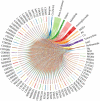Genotype diversity and antibiotic resistance risk in Aeromonas hydrophila in Sichuan, China
- PMID: 37999911
- PMCID: PMC10920602
- DOI: 10.1007/s42770-023-01187-9
Genotype diversity and antibiotic resistance risk in Aeromonas hydrophila in Sichuan, China
Abstract
Sichuan is a significant aquaculture province in China, with a total aquaculture output of 1.72 × 106 tons in 2022. One of the most significant microorganisms hurting the Sichuan aquaculture is Aeromonas hydrophila, whose genotype and antibiotic resistance are yet unknown. This study isolated a total of 64 strains of A. hydrophila from various regions during September 2019 to June 2021 within Sichuan province, China. The technique of Multi-Locus Sequence Typing (MLST) was used for the purpose of molecular typing. Meanwhile, identification of antibiotic resistance phenotype and antibiotic resistance gene was performed. The findings of the study revealed that 64 isolates exhibited 29 sequence types (ST) throughout different regions in Sichuan, with 25 of these ST types being newly identified. Notably, the ST251 emerged as the predominant sequence type responsible for the pandemic. The resistance rate of isolated strains to roxithromycin was as high as 98.3%, followed by co-trimoxazole (87.5%), sulfafurazole (87.5%), imipenem (80%), amoxicillin (60%), and clindamycin (57.8%). Fifteen strains of A. hydrophila exhibited resistance to medicines across a minimum of three categories, suggesting the development of multidrug resistance in these isolates. A total of 63 ARGs were detected from the isolates, which mediated a range of antibiotic resistance mechanisms, with deactivation and efflux potentially serving as the primary mechanisms of antibiotic resistance. This study revealed the diversity of A. hydrophila genotypes and the risk of antibiotic resistance in Sichuan, providing reference for scientific and effective control of A. hydrophila infection.
Keywords: Aeromonas hydrophila; Antibiotic resistance gene; Antibiotic resistance phenotype; Aquatic animal; MLST.
© 2023. The Author(s) under exclusive licence to Sociedade Brasileira de Microbiologia.
Conflict of interest statement
The authors declare no competing interests.
Figures





Similar articles
-
Genotyping and antimicrobial susceptibility of Aeromonas veronii isolated from aquatic animals in Sichuan, China.Antonie Van Leeuwenhoek. 2025 Apr 18;118(5):69. doi: 10.1007/s10482-025-02086-9. Antonie Van Leeuwenhoek. 2025. PMID: 40249466
-
Aeromonas hydrophila ST251 and Aeromonas dhakensis are major emerging pathogens of striped catfish in Vietnam.Front Microbiol. 2023 Jan 26;13:1067235. doi: 10.3389/fmicb.2022.1067235. eCollection 2022. Front Microbiol. 2023. PMID: 36794008 Free PMC article.
-
Multilocus sequence typing and antibiotic resistance of Aeromonas isolated from freshwater fish in Hebei Province.PLoS One. 2024 Mar 27;19(3):e0298745. doi: 10.1371/journal.pone.0298745. eCollection 2024. PLoS One. 2024. PMID: 38536889 Free PMC article.
-
Phenotypic, molecular detection, and Antibiotic Resistance Profile (MDR and XDR) of Aeromonas hydrophila isolated from Farmed Tilapia zillii and Mugil cephalus.BMC Vet Res. 2024 Mar 8;20(1):84. doi: 10.1186/s12917-024-03942-y. BMC Vet Res. 2024. PMID: 38459543 Free PMC article.
-
Isolation, Identification, and Characterisation of a Novel ST2378 Aeromonas hydrophila Strain from Naturally Diseased Frogs, Rana dybowskii.Pathogens. 2024 Jun 30;13(7):552. doi: 10.3390/pathogens13070552. Pathogens. 2024. PMID: 39057779 Free PMC article.
Cited by
-
Synergistic Efficacy of Doxycycline and Florfenicol Against Aeromonas hydrophilia and Morganella morganii Infections in Pelodiscus sinensis with Skin Ulcer Disease.Vet Sci. 2025 Jun 23;12(7):611. doi: 10.3390/vetsci12070611. Vet Sci. 2025. PMID: 40711271 Free PMC article.
-
Novel Insights into the Therapeutic Effect of Amentoflavone Against Aeromonas hydrophila Infection by Blocking the Activity of Aerolysin.Int J Mol Sci. 2025 Mar 6;26(5):2370. doi: 10.3390/ijms26052370. Int J Mol Sci. 2025. PMID: 40076989 Free PMC article.
References
-
- Rashidian G, Boldaji JT, Rainis S, Prokic MD, Faggio C. Oregano (Origanum vulgare) extract enhances zebrafish (Danio rerio) growth performance, serum and mucus innate immune responses and resistance against Aeromonas hydrophila challenge. Animals (Basel) 2021;11:299. doi: 10.3390/ani11020299. - DOI - PMC - PubMed
MeSH terms
Substances
Grants and funding
LinkOut - more resources
Full Text Sources

